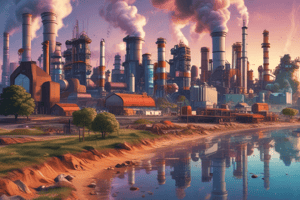Podcast
Questions and Answers
Which of the following best describes the key difference between non-absorbable and absorbed pollutants?
Which of the following best describes the key difference between non-absorbable and absorbed pollutants?
- Non-absorbable pollutants primarily affect aquatic ecosystems, while absorbed pollutants affect terrestrial ecosystems.
- Non-absorbable pollutants are always organic, while absorbed pollutants are inorganic.
- Non-absorbable pollutants persist in the environment over long periods, while absorbed pollutants can be broken down naturally. (correct)
- Non-absorbable pollutants are only harmful in small quantities, while absorbed pollutants are harmful at any concentration.
Why does the marginal cost of pollution abatement (MCC) typically increase as more pollution is reduced?
Why does the marginal cost of pollution abatement (MCC) typically increase as more pollution is reduced?
- Because the demand for cleaner technologies decreases as pollution is reduced.
- Because the initial costs of abatement are greater, and those costs are shared across all levels of reduced pollution.
- Because less experienced firms are tasked with abatement.
- Because the easiest and cheapest methods are employed first, requiring more costly methods later. (correct)
Which of the following is an example of a non-absorbable pollutant?
Which of the following is an example of a non-absorbable pollutant?
- Organic waste
- Carbon dioxide ($CO_2$)
- Mercury (correct)
- Nitrous oxide ($N_2O$)
Which best illustrates the concept of an absorbed pollutant becoming harmful?
Which best illustrates the concept of an absorbed pollutant becoming harmful?
What does the upward slope of the marginal cost of pollution abatement (MCC) curve indicate?
What does the upward slope of the marginal cost of pollution abatement (MCC) curve indicate?
How would a persistent accumulation of plastic waste in the ocean and on land be classified?
How would a persistent accumulation of plastic waste in the ocean and on land be classified?
Given that a company has already implemented all the low cost pollution abatement techniques, what would be the next steps and cost implications?
Given that a company has already implemented all the low cost pollution abatement techniques, what would be the next steps and cost implications?
What factor primarily determines whether a pollutant is classified as 'absorbed' or 'non-absorbable'?
What factor primarily determines whether a pollutant is classified as 'absorbed' or 'non-absorbable'?
Flashcards
Non-Absorbable Pollutants
Non-Absorbable Pollutants
Pollutants that do not break down in the environment and persist for long periods, causing ongoing damage.
Absorbed Pollutants
Absorbed Pollutants
Pollutants that can be broken down or absorbed by natural processes over time, but can still cause harm if their levels exceed the environment's capacity.
Heavy metals and plastics
Heavy metals and plastics
Examples of non-absorbable pollutants, persisting in the environment for decades or centuries, causing harm to organisms.
Marginal Cost of Pollution Abatement (MCC)
Marginal Cost of Pollution Abatement (MCC)
Signup and view all the flashcards
Marginal Cost of Pollution Damage (MDC)
Marginal Cost of Pollution Damage (MDC)
Signup and view all the flashcards
MCC curve
MCC curve
Signup and view all the flashcards
Why MCC curve slopes upward
Why MCC curve slopes upward
Signup and view all the flashcards
Socially Optimal Level of Pollution
Socially Optimal Level of Pollution
Signup and view all the flashcards
Study Notes
Pollutant Classification
- Pollutants are categorized by how they interact with the environment:
- Non-Absorbable Pollutants: These pollutants persist in the environment, causing long-term damage. They don't break down or assimilate. Examples include heavy metals (mercury, lead) and plastics. These pollutants can remain active for decades or centuries, accumulating in ecosystems and harming organisms. Plastic waste in oceans is a key example – plastic doesn't biodegrade and poses danger to marine life, lasting for centuries.
- Absorbed Pollutants: These pollutants can be broken down or absorbed by natural processes over time. Examples include carbon dioxide (CO2) and nitrous oxide (N2O). While harmful in excess, they can be absorbed by plants or naturally degraded. However, if the level exceeds the ecosystem's capacity, damage can still result, as seen in CO2 accumulation, leading to climate change.
Economic Analysis of Pollution
- Marginal Cost of Pollution Abatement (MCC): Represents the cost of reducing one additional unit of pollution. The MCC curve rises as more pollution is reduced because the easiest/cheapest methods are applied first. As more reduction is needed, more costly solutions become necessary, like carbon capture and storage.
- Marginal Cost of Pollution Damage (MDC): Represents the economic cost of one additional unit of pollution. This includes health impacts, ecosystem harm, and economic losses. The MDC curve increases as pollution increases because the damage worsens (more extreme weather, rising sea levels, etc. with increased carbon emissions).
Studying That Suits You
Use AI to generate personalized quizzes and flashcards to suit your learning preferences.
Description
This quiz explores the classification of pollutants based on their environmental interactions, differentiating between non-absorbable and absorbed pollutants. It also discusses the economic impacts of pollution, including the marginal costs associated with these pollutants. Test your knowledge on these crucial environmental topics.




